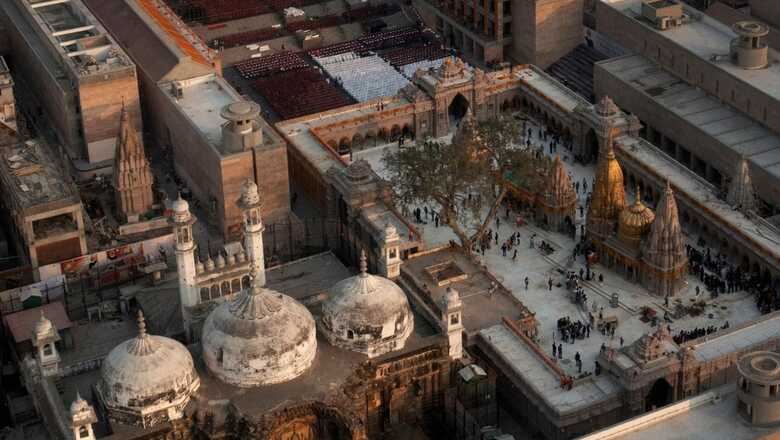
views
The bubble of mendacity is at bursting point. The Archaeological Survey of India’s report on the Gyanvapi mosque complex has unearthed what was always known.
It has concluded that, “there existed a Hindu temple prior to the construction of the existing structure.”
The ASI had carried out a scientific survey of the Gyanvapi premises, located next to the Kashi Vishwanath temple, to determine whether the 17th-century mosque was constructed over the original temple dedicated to Mahadev.
The Hindu side that wants to reclaim the site on which the Gyanvapi mosque has been built is convinced that it was built upon the original temple dedicated to Lord Shiva.
The Muslim side, represented by the Gyanvapi Masjid Committee, denies this. And for good measure, it has also rejected the ASI’s findings.
This will not be the first time either. After the Ayodhya judgement, the Muslim petitioners in that case too never tired of pointing out that the ASI had also not been able to conclusively conclude that the ruins of a temple found under the Babri Masjid belonged to a temple that had been actually destroyed by the Mughals to build the mosque.
Just as with Ayodhya, the contest over the Gyanvapi mosque is also playing out in court.
While it is always advisable to wait for the report’s findings to be thoroughly scrutinised, there is, aside from archeological evidence, widespread historical consensus that the site of the Gyanvapi mosque was witness to a terrible desecration.
The most convincing account of this odious vandalism is offered by the vandal himself: Emperor Aurangzeb.
Saqi Mustad Khan, an official in Aurangzeb’s court, was tasked by the bigoted Mughal himself to chronicle his rule — past, present, and future. The chronicle called ‘Maasir-i-Alamgiri’ records with unabashed admiration that Aurangzeb gave orders to destroy all schools and temples in Varanasi and other parts of India. Khan notes that on September 2, 1669, Aurangzeb’s orders were duly carried out by his bigoted cohorts, and the original Kashi Vishwanath Temple was demolished.
Even if we are to discount this most consequential proof, other equally persuasive accounts exist, confirming the tyranny unleashed by Aurangzeb on the Kashi Vishwanath temple.
Peter Mundy, a self-professed “East India Company servant”, wrote in his memoir “A journey from Agra to Puttana” of a time in September 1632 when he chanced upon Hindu “women pouring libations over the lingam” in Varanasi. Moved by their devotion, he drew a sketch of the scene titled “Mahadev”.
Mundy’s account is critical to the case as it was penned 37 years before Aurangzeb gave his order to demolish the Kashi Vishwanath temple. As such, he was one of the last persons to have recorded the existence of the fabled temple.
Then there’s British administrator James Prinsep, who noted the oddity of a Muslim structure straddling a Hindu temple by remarking pithily that the “dome & minaret surmounting the Hindu walls were the work of Aurangzeb”.
Incidentally, the authenticity of these accounts has never been called into question and therefore constitute important evidence in support of the Hindu claim.
Above and beyond the historical record, there’s an even more compelling fact.
This fact confirms that the land on which the Gyanvapi mosque stands today was sullied by an unforgiving act of religious zealotry.
The Allahabad High Court itself notes that “there is no material on record to demonstrate the creation of Waqf and construction of Mosque”.
It’s a well-established fact in Islamic religious law that a waqf can only be established for the construction of a mosque on pristine land. Any mosque built on “impure” land is not deemed suitable enough for the purpose of offering prayers.
Had the land not been desecrated by a wanton act of blind fury brought on by Aurangzeb’s inherent hate for Hindus, the waqf would have been created on paper and a record of it would have existed.
There’s also, of course, the weight of lived experience. Hari Shankar Jain, representing five women petitioners from the Hindu side, has collected testimonies of 10 witnesses who said that puja of deities was conducted continuously at the Gyanvapi mosque.
In 1993, however, Mr Jain notes, the Mulayam Singh Yadav-led SP government fenced off the mosque, denying Hindus their right to worship at Gyanvapi.
Indeed, establishing the Hindu character of the Gyanvapi mosque will be easy. But, thanks to the ideological left, taking possession of it won’t be.
That’s because, in 1991, the then Congress-led PV Narasimha Rao government at the Centre enacted the Places of Worship Act.
Whether this was done to appease the Muslim community or not is irrelevant. At least in the legal context. But the fact is that the 1991 law effectively froze the status of any place of worship as it was before August 15, 1947. In other words, the law stands in the way of Hindus reclaiming the Gyanvapi mosque site to alter its status.
True, the battle to overturn the law is being waged in the Supreme Court. But a resolution is unlikely anytime soon. Especially because the present CJI DY Chandrachud has himself vouched for the constitutional validity of the Places of Worship Act 1991.















Comments
0 comment